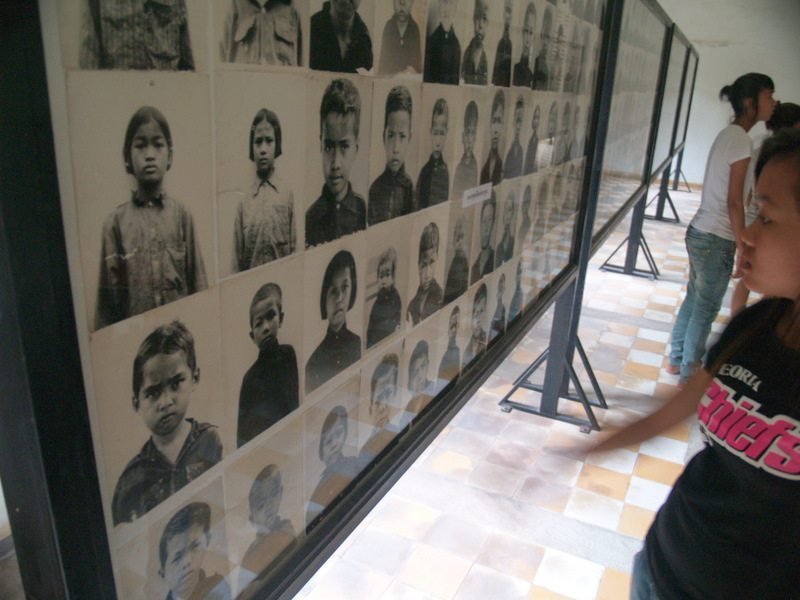School of Atrocity: Phnom Penh’s Tuol Sleng Genocide Museum (S21)
 Ghostly reflections of the faces behind us lay on the plastic over the faces before us. Faces, endless faces – men, old and young, women, children, even infants in their mothers’ arms, perhaps blissfully unaware of the terror of their mothers. One photo grabbed my attention. It was a girl of about 5 or 6 who looked like someone who is just learning she can’t always have whatever she wants, a sort of resigned disappointment, but not a childish pout – a knowledge of something bigger than having and wanting. She looked off to her left instead of at the camera like all the others. It could have been a cute portrait of a child showing a glimmer of growing up. Not long after that picture was taken, however, she was executed; hopefully for her sake without torture or preamble, but most likely something brutal and violent. Then she was tossed into a heap of other bodies at the bottom of a hole in a field.
Ghostly reflections of the faces behind us lay on the plastic over the faces before us. Faces, endless faces – men, old and young, women, children, even infants in their mothers’ arms, perhaps blissfully unaware of the terror of their mothers. One photo grabbed my attention. It was a girl of about 5 or 6 who looked like someone who is just learning she can’t always have whatever she wants, a sort of resigned disappointment, but not a childish pout – a knowledge of something bigger than having and wanting. She looked off to her left instead of at the camera like all the others. It could have been a cute portrait of a child showing a glimmer of growing up. Not long after that picture was taken, however, she was executed; hopefully for her sake without torture or preamble, but most likely something brutal and violent. Then she was tossed into a heap of other bodies at the bottom of a hole in a field.
The faces go on and on from room to room in what was once a school building and even today shows those familiar tile floors, universally academic. But these classrooms were turned into prison cells and torture  rooms by the Khmer Rouge in 1975. Almost three decades later students are once again wandering these halls, but now they are travelers or Cambodians coming to learn a gruesome lesson of history.
rooms by the Khmer Rouge in 1975. Almost three decades later students are once again wandering these halls, but now they are travelers or Cambodians coming to learn a gruesome lesson of history.
Throughout Security Prison 21, known simply as S-21 and now Tuol Sleng Genocide Museum, is a horrific collection that testifies to humankind’s worst side. The enormity of the violence challenges the mind; the evidence of it, the stomach.
The last 14 of the estimated 17,000-plus victims of this facility are buried in the schoolyard where children once played. The graves lie just before a large wooden frame on the playground that became a place to hang victims from their wrists tied behind their backs until they passed out from the pain. Torture went on right up until the Khmer Rouge was driven from the building by the approaching joint forces of Cambodian and Vietnamese military in 1979. These last 14 people were found dead, chained to metal bed frames and twisted in final agony. Today large black and white photos in each room show the hideous mutilations and pools and spatters like black ink across the floors and walls around them.
Those brought to S 21 were suspected of treason or even having an education or simply being family of someone who went to the university. Victims who survived “questioning” were sent off to Choeung Ek, one of the infamous Killing Fields just outside Phnom Penh, sometimes with the false hope that they were being released. Prisoners were tortured until they gave up some names and then the next list was brought in. Often whole families were executed. Later, as perhaps some within the ranks began to question the success of the “revolution,” Khmer Rouge leader Pol Pot started having his own party members moved into S-21, tortured, and executed.
 Paintings on site show torture techniques, such as fingernails being pulled out, electric shocks, and worse. One room is dedicated to personal stories of survivors or the families of victims. Some stories are from executioners who feared for their own lives enough to commit torture and murder. Another hall explains the history of the Khmer Rouge movement and their political ambition to create a better society by eliminating class and moving all the city people into the countryside to work the rice paddies. A documentary is shown at the museum twice daily. And then there are the skulls — loads of them, but not nearly as many as at Choeung Ek, the Killing Fields. A visit here should be completed with a visit to Choeung Ek where only a fraction of the mass graves have been excavated. Pieces of clothing and bone emerge from the dust all across the fields.
Paintings on site show torture techniques, such as fingernails being pulled out, electric shocks, and worse. One room is dedicated to personal stories of survivors or the families of victims. Some stories are from executioners who feared for their own lives enough to commit torture and murder. Another hall explains the history of the Khmer Rouge movement and their political ambition to create a better society by eliminating class and moving all the city people into the countryside to work the rice paddies. A documentary is shown at the museum twice daily. And then there are the skulls — loads of them, but not nearly as many as at Choeung Ek, the Killing Fields. A visit here should be completed with a visit to Choeung Ek where only a fraction of the mass graves have been excavated. Pieces of clothing and bone emerge from the dust all across the fields.
 But perhaps most important of all at S 21 are the photos. Much like the Nazis, the Khmer Rouge was compelled to document what they did here. Why? Black and white photos of so many faces with a number beneath the chin indicating the count of people being sent to their deaths. All recorded for us to see. We look into the eyes of a person marked for death. And another person. And another. And a young girl. An old man. And a mother cradling an infant. A young boy whose wide eyes conveyed the horror and confusion.
But perhaps most important of all at S 21 are the photos. Much like the Nazis, the Khmer Rouge was compelled to document what they did here. Why? Black and white photos of so many faces with a number beneath the chin indicating the count of people being sent to their deaths. All recorded for us to see. We look into the eyes of a person marked for death. And another person. And another. And a young girl. An old man. And a mother cradling an infant. A young boy whose wide eyes conveyed the horror and confusion.
The Khmer Rouge in their mad quest for a society free of classes tried to dehumanize the enemy in order to exterminate them and “cleanse” the population. But this is always a failed proposition. And though it may be little consolation for the dead or those who mourn them, it is a truth that history bears out sooner or later: Those who work to dehumanize others, only end up dehumanizing themselves. The victims are mourned and remembered as heroes or martyrs. The perpetrators end up immortalized as monsters.
My blog post from the day I visited Tuol Sleng S21 Museum
Other Mad Traveler blog posts about Cambodia
_____________________________________
 More news about the current genocide trials:
More news about the current genocide trials:
February 2012: Khmer Rouge chief jailer gets life in prison (Associated Press) The controversially short sentence for Duch is extended for life.
March 2011: Cambodian Immigrants Seek Healing in Khmer Rouge Genocide Trial (One World Group)
February 2011: Khmer Rouge leaders to await trial in prison (Radio Netherlands Worldwide)
September 2010: Khmer Rouge Leaders Indicted (NYT)
July 2010: Khmer Rouge prison chief Duch found guilty (BBC)
July 16 2009:
Note April 2009: Kaing Khek Iev also known as Duch was the official in charge of S-21. He has been in jail awaiting trial since 2001. That trial is facing a lot of challenges but efforts are still underway to bring justice and closure to an ugly page in Khmer history.
http://www.cnn.com/2009/WORLD/asiapcf/03/29/cambodia.tribunal
See more photos from the prison: http://www.tuolsleng.com
Tuol Sleng Genocide Museum
Street 113, Phnom Penh 12210 Cambodia
+855 23 30 0698
Hours 7–11:30, 2–5:30
Admission is $2





 ORDER YOUR COPY TODAY!
ORDER YOUR COPY TODAY! ORDER YOUR COPY TODAY!
ORDER YOUR COPY TODAY!
Pingback: Cambodia: S-21, The Tuol Sleng Genocide Museum
Pingback: Travel Photo of the Week: Angkor Wat
Pingback: Photo Gallery: Children of Syria
Pingback: Searching for Sophie: Munich, the White Rose, and Sophie Scholl